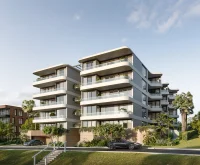MICAVillage Green
Taking on the challenge of achieving density and infill in Canberra’s sprawling mid-century suburbs, MICA sets a new precedent for mixed-use, residential-led development, built to last and celebrating the gentler moments of neighbourhood life.
Taking on the challenge of achieving density and infill in Canberra’s sprawling mid-century suburbs, MICA sets a new precedent for mixed-use, residential-led development, built to last and celebrating the gentler moments of neighbourhood life.
Location
Campbell
State
ACT
Country
Ngunnawal
Client
Maxon Group
Expertise
Residential, Commercial, Interiors
Year
2021
Collaborators
Veris, Indesco, Northrop, Ignis Solutions, Paradigm42
Photography
Tom Roe
1/7
Brief
The homes in Campbell were largely designed in the 1950s and 1960s on (what are now) well-established plots. Building higher-density developments of multiple homes – here, 9 apartments and 10 townhouses – can be difficult in this type of context, where structures of larger scale can disrupt an urban fabric that has evolved over many decades. The site for MICA, a corner plot next to a low-key, parking-centred retail arcade, also suggested that the building should have a public-facing role, seen in the round and working with the shops to reinforce this as the focal point of the neighbourhood.
The homes in Campbell were largely designed in the 1950s and 1960s on (what are now) well-established plots. Building higher-density developments of multiple homes – here, 9 apartments and 10 townhouses – can be difficult in this type of context, where structures of larger scale can disrupt an urban fabric that has evolved over many decades. The site for MICA, a corner plot next to a low-key, parking-centred retail arcade, also suggested that the building should have a public-facing role, seen in the round and working with the shops to reinforce this as the focal point of the neighbourhood.
Design
Our design is the product of conversations with community members to develop a suitable scale, look and feel for the development. Although a distinctive building, it works to reinforce what is already there, our main architectural move being to activate the ground floor at its principal corner where pedestrians enter the shopping arcade from a nearby road crossing. Apartments are placed above, and two-storey townhouses adjacent, stepping up a little from the pavement. The homes work with the shops, but still feel private and comfortable, with curved balconies and open circulation to encourage sociability and movement around and into the building. Although the main materials – red brick cladding and a stone base – are drawn from the mid-century context, the detailing is contemporary, articulating the corner and helping to break down the overall mass.
Our design is the product of conversations with community members to develop a suitable scale, look and feel for the development. Although a distinctive building, it works to reinforce what is already there, our main architectural move being to activate the ground floor at its principal corner where pedestrians enter the shopping arcade from a nearby road crossing. Apartments are placed above, and two-storey townhouses adjacent, stepping up a little from the pavement. The homes work with the shops, but still feel private and comfortable, with curved balconies and open circulation to encourage sociability and movement around and into the building. Although the main materials – red brick cladding and a stone base – are drawn from the mid-century context, the detailing is contemporary, articulating the corner and helping to break down the overall mass.
Impact
MICA is an inherently public building, due to its mix of uses and prominent position. It was important to us to pitch it correctly: it should feel suburban rather than civic, have a reinvigorating impact on the neighbourhood rather than a transformational one. The homes have sold very quickly, and the community has been quick to adopt the street-facing stoop outside the ground-floor café, suggesting that we have achieved this tricky balance.
Good architecture gives more than it takes. MICA is a lifter not a leaner. - AIA ACT Awards Jury Citation.
MICA is an inherently public building, due to its mix of uses and prominent position. It was important to us to pitch it correctly: it should feel suburban rather than civic, have a reinvigorating impact on the neighbourhood rather than a transformational one. The homes have sold very quickly, and the community has been quick to adopt the street-facing stoop outside the ground-floor café, suggesting that we have achieved this tricky balance.
Good architecture gives more than it takes. MICA is a lifter not a leaner. - AIA ACT Awards Jury Citation.
Awards
2022
Award, Residential Architecture: Multiple Housing, Australian Institute of Architects ACT
2022
Award, Residential Architecture: Multiple Housing, Australian Institute of Architects ACT










